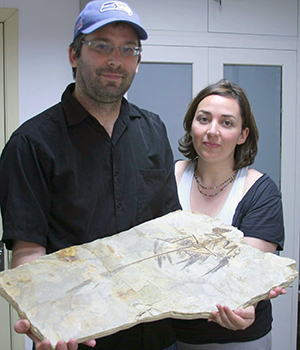
Analysis for the distribution of shapes of melanin-containing organelles (melanosomes) in fossil and living amniotes shows that fuzz-covered dinosaurs like Sinosauropteryx share similarities with living lizards, turtles and crocodilians. Photo credit: Li et al. (authors).
An unexpected discovery made by University of Akron biologist Matthew Shawkey and a team of research colleagues from Texas and China found that the shape of melanosomes (animal cell pigment granules) from ancient feathered dinosaurs may indicate that the animals shifted from being cold-blooded to warm, reported the journal Nature Feb. 12.
Shawkey and researchers at the University of Texas at Austin’s School of Geosciences and five Chinese university partners were attempting to identify the colors of prehistoric mammals and reptiles by examining the shapes of fossilized melanosomes when they stumbled upon the discovery.

Research by Matthew Shawkey (left), UA associate professor of biology, and Liliana D’Alba (right), UA post doctoral researcher, and an international team of scientists suggests that a physiological transition occurred in dinosaurs at the origin of feathers.
"Lo and behold we found that the relationship between melanosome shape and color applied to birds and mammals, but not to reptiles. These pigments tell us more than color. We can look at melanosomes of living and fossil animals and make broader inferences as to how dinosaurs lived and behaved," says Shawkey, noting that warm-blooded creatures have higher metabolisms and higher aggression levels than cold-blooded animals.
The research team examined melanosomes from prehistoric mammal and reptile fossil specimens to see if they could determine their coloration. They compared the prehistoric melanosomes with those of reptiles in existence. This was the same method Shawkey and his research colleagues used in 2010 to reconstruct the plumage color of an extinct, non-avian dinosaur known as Anchiornis huxleyi.
"The shapes of melanosomes distinctly vary in the lineage of dinosaurs leading to birds (maniraptoran dinosaurs), unlike those of lizards, turtles and crocodiles, which showed limited diversity in shape," Shawkey says. Because melanin production is physiologically linked to metabolism through what is called the melanocortin system, the finding suggests that a physiological transition, potentially from cold-blooded to warm-blooded, occurred at around the origin of branched feathers.
However, when it comes to the prehistoric animals' skin color, that mystery is yet to be uncovered.
“Since the association between the shape of melanosomes and pigment holds true only for feathers and some mammal hair, we cannot use this method to determine dinosaurs' skin color," Shawkey says.
So, which is a T-Rex's actual color — brown, green or something in between?
Shawkey says scientists will have to find a new method, perhaps using chemistry, to find out. Stay tuned.
Media contact: Denise Henry, 330-972-6477 or henryd@uakron.edu.

